Ski: 2024-2025 Zag Harfang 96, 182 cm
Test Locations: Taos Ski Valley, NM; Crested Butte Mountain Resort, CO
Days Skied: ~20 total
Available Lengths: 170, 176, 182, 188 cm
Blister’s Measured Tip-to-Tail Length (straight-tape pull): 182.1 cm
Stated Weight per Ski: 1990 grams
Blister’s Measured Weight per Ski: 2008 & 2043 grams
Stated Dimensions: 132.5-96-117 mm
Blister’s Measured Dimensions: 132.7-95.2-116.9 mm
Stated Sidecut Radius (182 cm): 20 meters
Measured Tip & Tail Splay (ski decambered): 55 mm / 11.5 mm
Measured Traditional Camber Underfoot: 5 mm
Core Materials: poplar + phenol binding reinforcement + fiberglass laminate
Base: sintered
Factory Recommended Mount Point: -12.05 cm from center; 79 cm from tail
[Note: Our review was conducted on the 22/23 Harfang 96, which returned unchanged for 23/24 and 24/25.]
Available Lengths: 156, 164, 170 cm
Blister’s Measured Tip-to-Tail Length (straight-tape pull): 169.1 cm
Stated Weight per Ski: 1760 grams
Blister’s Measured Weight per Ski: 1788 & 1793 grams
Stated Dimensions: 131-96-115.5 mm
Blister’s Measured Dimensions: 131.4-95.3-115.7 mm
Stated Sidecut Radius (170 cm): 17.5 meters
Measured Tip & Tail Splay (ski decambered): 50.5 mm / 11.5 mm
Measured Traditional Camber Underfoot: 5.5 mm
Factory Recommended Mount Point: -10.95 cm from center; 73.6 cm from tail

Intro
The Harfang collection constitutes ZAG’s do-everything, directional line of all-mountain and freeride skis. Compared to the brand’s Slap series (see our review of the Slap 104), the Harfang skis generally feature more rearward mount points, flatter / less-rockered tails, and cater to more traditional skiing styles — but still aim to perform in a wide range of conditions and terrain.
For the past couple of seasons, we’ve been testing two lengths of the middle child of the Harfang family, the Harfang 96 (aka, “H-96”). As with many of their skis, ZAG offers the H-96 in two versions, the standard “H-96” and the “H-96 Lady.” The two share the same construction but feature different color options and different available lengths. The blue-and-yellow H-96 comes in 170, 176, 182, and 188 cm lengths; the red-and-turquoise H-96 is offered in 156, 164, and 170 cm lengths.
We’ve had multiple female and male reviewers on these skis, and now it’s time to weigh in on where they slot into the all-mountain market. First, let’s cover the design details of the Harfang 96.
What Zag says about the Harfang 96:
“The most versatile ski of the line. It adapts to all snow conditions, all speeds and all snow types.
Developed and used by the ski patrollers of the Mont-Blanc Valley, the H-96 offers comfort, security, and performance on the whole mountain. Not only does this ski glide through turns of any size on-piste, the H-96 will lead you to untracked powder fields. Maneuverability and ease-of-use makes this the perfect match for those searching for a ski that does everything.”
Construction / Materials
The Harfang series features ZAG’s “Heavy Duty Construction,” which includes a full poplar wood core, multiple layers of quadraxial fiberglass, a Phenol binding-reinforcement plate, and a 50% bio-sourced polyamide top sheet. On that note, the Harfang skis also reportedly use a 25% bio-based resin, 85% recycled base material for the black portions, and recycled steel edges. The Harfang skis are made in Poland with the majority of the materials being sourced within Europe.
Shape / Rocker Profile
The H-96 is a story of two parts: the front and the back. In front of the bindings, the H-96 features notably tapered and rockered tips — particularly compared to similarly directional skis around the same width. Behind the bindings, the H-96 has a much less tapered and minimally rockered tail.
Flex Pattern
Here’s how we’d characterize the flex pattern of the 182 cm Harfang 96:
Tips: 6.5
Shovels: 6.5-7
In Front of Toe Piece: 7.5-10
Underfoot: 10
Behind the Heel Piece: 9.5-9
Tails: 9
And here’s how we’d characterize the flex pattern of the 170 cm Harfang 96:
Tips: 7
Shovels: 7-8
In Front of Toe Piece: 8.5-9.5
Underfoot: 10
Behind the Heel Piece: 9.5-8.5
Tails: 8.5-9
Overall, this is a pretty strong ski. Its tips and shovels are a good bit softer than the back of the ski, making for a directional flex pattern that’s in line with the rest of the ski’s design.
Sidecut Radius
We’ve been testing the 170 cm and 182 cm H-96, which have stated sidecut radii of 17.5 m and 20 m, respectively. Those are slightly on the longer end of the spectrum for this class, but not wildly out of the ordinary.
Mount Point
At about -12 cm from true center for the 182 cm and -11 cm for the 170 cm, the H-96’s recommended mount point is very traditional / rearward (more on this later).
Weight
Our 170 cm H-96 came in at just under 1800 grams per ski, while our 182 cm version is a bit over 2000 grams per ski. That puts the H-96 somewhere near the middle of the weight spectrum for its class, if not slightly on the heavier side of things. But it doesn’t really stand out in this regard, on paper.
For reference, here are a number of our measured weights (per ski in grams) for some notable skis. Keep in mind the length differences to try to keep things apples-to-apples. We’ll soon be updating this list with more skis that are comparable to the 170 cm H-96.
1707 & 1752 4FRNT Switch, 184 cm
1800 & 1824 Romp Zorro 100, 183 cm
1805 & 1833 Liberty Origin 101, 182 cm
1806 & 1884 Head Oblivion 102, 189 cm
1808 & 1823 Shaggy’s Ahmeek 95, 180 cm
1816 & 1819 Head Kore 99, 184 cm
1821 & 1838 Stöckli Stormrider 95, 182 cm
1824 & 1843 Season Kin, 181 cm
1831 & 1844 K2 Mindbender 96C, 178 cm
1869 & 1873 Line Sakana, 181 cm
1880 & 1887 Blizzard Rustler 9, 180 cm
1883 & 1906 Season Aero, 180 cm
1894 & 1919 RMU Apostle 96 Pro, 184 cm
1896 & 1942 K2 Reckoner 102, 184 cm
1901 & 1902 Renoun Endurance 98, 184 cm
1925 & 1934 Black Crows Camox, 186 cm
1929 & 1982 Faction Mana 2, 183 cm
1935 & 1962 Fischer Ranger 96, 180 cm
1938 & 2003 Nordica Unleashed 98, 186 cm
1946 & 1962 Black Crows Atris, 184 cm
1946 & 1968 Salomon Stance 96, 182 cm
1951 & 1957 RMU Apostle 106, 184 cm
1956 & 1976 Blizzard Rustler 10, 186 cm
1975 & 2028 Armada Declivity 102 Ti, 180 cm
1981 & 1991 Faction Dancer 2, 182 cm
1990 & 2045 Peak 104 by Bode, 184 cm
1997 & 2001 ZAG Slap 104, 188 cm
1998 & 2010 Stöckli Stormrider 102, 182 cm
2008 & 2043 ZAG Harfang 96, 182 cm
2019 & 2022 Rossignol Blackops 98, 182 cm
2019 & 2024 Salomon Stance 102, 183 cm
2024 & 2112 Dynastar M-Free 99, 185 cm
2034 & 2060 Peak 98 by Bode, 184 cm
2042 & 2062 Dynastar M-Pro 99, 186 cm
2054 & 2063 Salomon QST 98, 189 cm
2057 & 2061 Fischer Ranger 102, 183 cm
2077 & 2096 Line Blade Optic 96, 184 cm
2079 & 2089 Shaggy’s Mohawk 98, 186 cm
2085 & 2120 K2 Mindbender 99Ti, 184 cm
2112 & 2149 J Skis Masterblaster, 181 cm
2165 & 2186 Wagner Summit 97, 182 cm
2178 & 2195 Volkl M6 Mantra, 184 cm
2281 & 2284 Blizzard Bonafide 97, 177 cm
2326 & 2336 Nordica Enforcer 100, 186 cm
Now, with those specs out of the way, let’s get into how all of this adds up on snow:
FULL REVIEW
Luke Koppa: We’ve been spending time on the 170 cm and 182 cm Harfang 96 (aka, “H-96”) for quite some time now, across multiple seasons and multiple ski areas, and between several different reviewers. To sum up our experiences, Kristin Sinnott and I will both be chiming in here in our Full Review, and in our Deep Dive comparisons, where we compare the H-96 to a whole bunch of other men’s, women’s, and unisex skis in its class.
Groomers / On piste
Luke (5’8”, 155 lbs / 173 cm, 70 kg): Overall, I’d call the H-96 a pretty “predictable” ski on piste. It’s not the most exhilarating in its class, nor is it some slouch when it comes to carving performance.
It seems sensible to start at the beginning (of the turn). Initiating carves on the H-96 requires some speed, pitch, and/or force, especially relative to other all-mountain skis with less tapered tips and/or tighter stated sidecut radii. At a listed 20 meters for the 182 cm length, the H-96’s sidecut radius isn’t wildly long by any means, but combined with its tapered and rockered shovels, that makes it a ski that wants you to tell it when to start really carving on edge, rather than the ski doing that part itself.
Still, it’s not like this is some burly straight ski — once you get used to its turn initiation and the speeds / technique required, the H-96 can be a lot of fun to carve. I’ve found this especially noteworthy in generally softer on-piste conditions, like mid-winter corduroy or later in the day in the spring once the snow has been warmed slightly by the sun. In those conditions, I can confidently get this ski high on edge and make turns ranging from roughly GS to Super G size.
The H-96’s traits that make it a bit more subdued when initiating carved turns also come with upsides — they make it more predictable than many of the snappier carvers in its class when hitting patches of variable snow, especially at speed.
The H-96 is also happy to skid, feather, and slide turns if you feel like taking it easy and not committing to aggressive carves. On very firm, scraped-off groomers, that’s often my approach on this ski; it can lay down aggressive carves in those conditions, but doing so requires good technique and an ability to trust the front of the ski to dig in when you drive it. It’s less that the ski won’t bend and cut into firm snow, and more that the slightly vague feel from the very end of the H-96 makes me feel less confident in the ski (and myself) when things are very firm. However, after spending a few laps becoming reacquainted with this ski, I can usually get it up to pretty high edge angles, even on firm snow.
Overall, the H-96 wouldn’t be my top pick for a ~95mm-wide all-mountain ski if on-piste excitement is a high priority for you. But it’s plenty capable in most groomed-trail scenarios, especially if you prefer a ski that feels predictable when making slightly larger, higher-speed turns, rather than one that’s extremely eager to carve tight turns across the fall line.
Kristin Sinnott (5’8”, 130 lbs / 173 cm, 59 kg): My first turns on the 170 cm H-96 were on a soft groomer and my first impression was that the ski felt intuitive. Part of this could be due to what Luke noted above about the H-96 being happy to skid, feather, and slide turns. You don’t have to ski the H-96 aggressively to enjoy a groomer. That said, to really get this ski in a proper carve, I needed to focus (a bit more than normal for this class of ski) on weighting my downhill ski. And the more energy I put into each turn, the more the H-96 rewarded me.
Another thing I noticed on my first run and just about every subsequent lap was that the H-96 feels very stiff in front of the bindings. Or maybe, it’s more that there’s a longer section of stiff ski in front of the bindings, due to the H-96’s fairly strong flex pattern + pretty rearward mount point (-11 cm on the 170 cm I’ve been skiing). This never really caused problems for me and I never felt the need to adjust the mount point forward, but it did feel like a lot of ski in front, despite the fact that I regularly ski (and enjoy) other directional all-mountain skis with mount points around the same spot (e.g., Salomon Stance 94, Blizzard Black Pearl 88, etc.). But this is likely part of why I found myself having to be a bit more deliberate about really driving the front of my downhill ski while carving the H-96.
Moguls, Trees, & Tight Terrain
Luke: How well you get along with the H-96 in general, and particularly in tight terrain, will likely come down to your specific skiing style and preferences regarding a few distinct traits.
Some of the defining aspects of the H-96 for me have been its fairly strong, minimally rockered, pretty flat tail and its very rearward recommended mount point (about -12 cm from true center on the 182 cm). Those two things equate to a ski that responds best to a traditional, directional, forward stance. The H-96 doesn’t feel that intuitive if you try to ski it more centered and pivot it from your ankles. Rather, it performs best when driving the front of the ski over and around obstacles, and, in turn, unweighting and freeing up its tails.
Following those instructions, the H-96 feels quite agile for what it is. Now, if you’re coming from less-rearward-mounted skis of similar weights (e.g., ZAG Slap 104), the H-96 won’t feel agile in the same way. More center-mounted skis often make it feel easy to flick them around from the toes of your boots, since they have less ski (and therefore, weight) out in front of you. On the H-96, there’s a lot of ski in front of you but less behind your boots, so once you initiate a turn through its shovels, its tails feel very quick to snap around.
Once I adjusted to this, I really enjoyed skiing the H-96 in tight terrain. I’m constantly switching between all sorts of different skis, including very directional ones, but I did have to tweak my go-to technique a bit more than usual when getting on the H-96. It had me focusing on being more deliberate about initiating each turn through the front and then quickly bringing around the back of the ski (as opposed to being able to easily pivot from the middle of the ski). But it was a fairly quick learning curve on the H-96 — while it encouraged a different approach, I almost immediately got an idea of what that approach was. And once I did, I enjoyed this different skiing style.
Putting that brief derailment on skiing style aside, once you get used to the sort of skiing it encourages in moguls and tight terrain, the H-96 feels quite agile for its class. It’s also pretty energetic when you bend it, which adds to the fun — mogul gaps and transitions quickly became a goal for me on this ski after the brief adjustment period.
Now, if (or when, in my case) you get backseat on the H-96, it feels notably less intuitive. On one hand, its tail doesn’t feel as punishingly stiff as I expected, given how strong it feels when hand-flexing the ski. But if you hang out in the backseat for a couple turns or more, the ski feels less predictable and easy to turn. Still, I was surprised by how much I could get away with when deliberately slashing out the tails of the H-96 from a pretty centered or even slightly backseat stance (see the GoPro photos…), so long as I shifted my weight forward shortly afterward.
ZAG’s Slap skis are definitely better options for folks who want a fairly forgiving ski for skiing tight terrain with a centered stance. But for those who take a more directional, forward-stance approach, I think most High-Intermediate, Advanced, and Expert directional skiers could get along well with the H-96.
Kristin: For reference, I am a very directional skier, though my style in tight terrain leans more toward finesse and precision than flat-out speed. My go-to body position is a traditional, forward stance, but leg fatigue, nerves, and other factors will inevitably put me in the backseat at times.
When skiing the H-96, I would have good and bad runs. If my legs were tired and I was prone to resorting to sloppier backseat skiing, the H-96’s tips would often deflect over a bump or some soft chop and I’d lose my confidence – thereby exacerbating the situation as I would then shift into an even less aggressive stance. As we’ve mentioned, it feels like there’s a significant amount of ski in front of you on the H-96, and it’s not a ski that does well when being skied from the tails.
On the other hand, when I am able to drive its shovels, I feel comfortable and confident making quick turns on the H-96 in tight terrain. I recently had one of my best bump runs of the season, and I skied it on the H-96. At the top of that run, I felt very hesitant to take the H-96 into the big, firm moguls below me. I had just skied Big Chute at CBMR, a very steep run that had some odd-shaped bumps, and the H-96’s tips had deflected a couple of times as I made my way through them, which left me feeling nervous and unsure of my ability to make quirk turns on the ski. Despite this, I eased my way into the following mogul line and, after a few turns, I was loving the ski. I wasn’t going fast for my standards but I was skiing at a consistent pace, focusing on maintaining my balance over the front of the ski so I could absorb each bump and the drive the ski down over / around it. With this approach, I was able to release the H-96’s tails and flick them around from my heels. It felt great.
Powder & Soft Chop
Luke: For a ~95mm-wide all-mountain ski, the H-96 handles fresh and lightly chopped-up snow quite well. Its rockered and tapered shovels do a good job of both planing up in soft snow and keeping the ski from feeling hooky. The H-96 isn’t all that wide and it doesn’t feature much tail rocker or tail taper, so it’s far from the most maneuverable ski in deeper snow. But for its class, I think the H-96 performs as well or better than most of its closest competitors when there’s fresh, soft snow to be found.
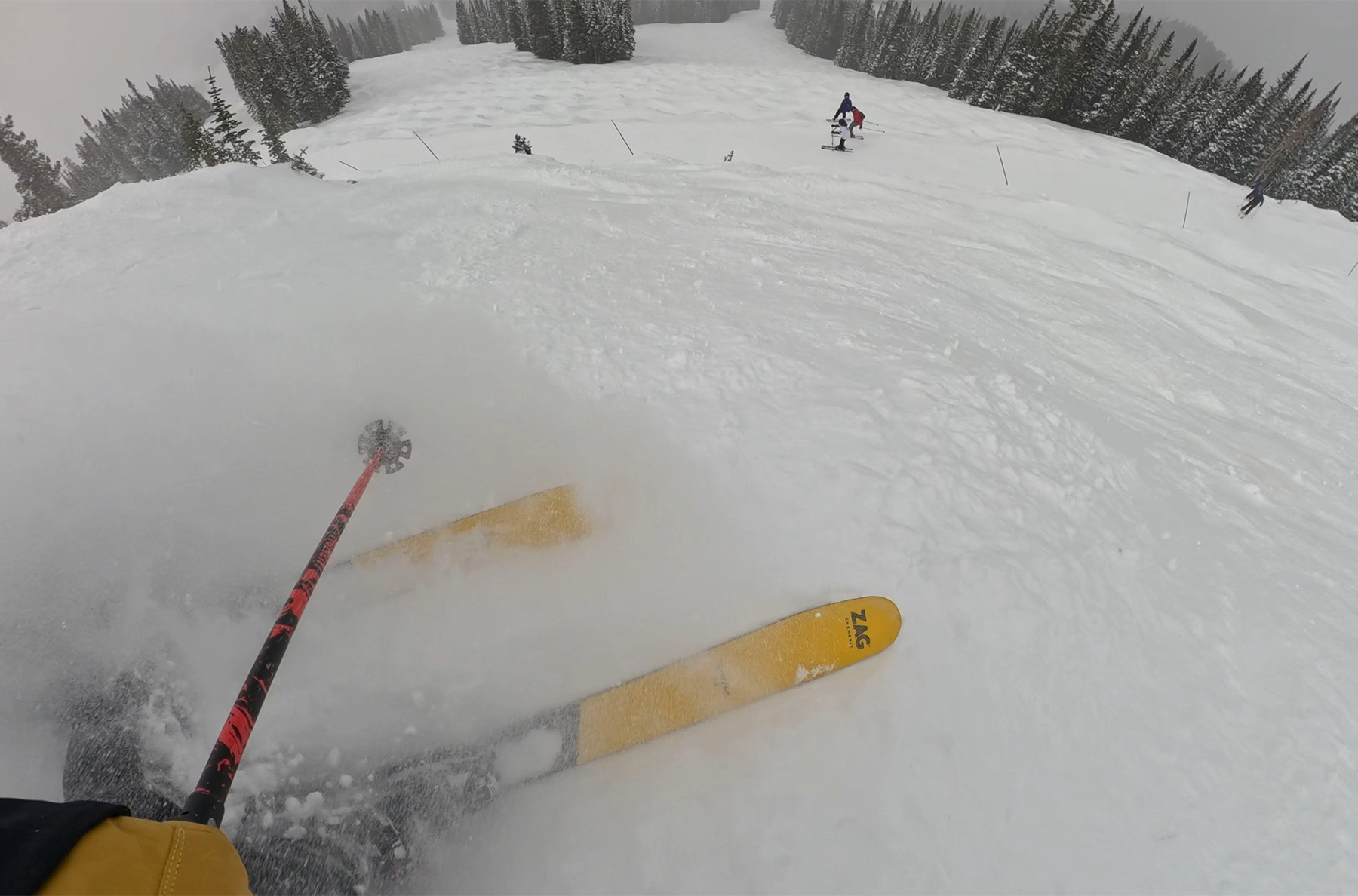
Kristin: As long as I wasn’t lazy or tired and I was skiing in a fairly forward, aggressive stance, the H-96 performed well in powder and soft chop. If I got in the backseat, I found the tips could easily get deflected and act unpredictably.
Firm Chop & Crud
Luke: The H-96’s predictability continues to be a standout feature in more challenging, rougher snow conditions.
At just a bit over 2000 grams per ski for the 182 cm length, the H-96 isn’t super heavy, but it’s also not wildly light. And I think it offers nice suspension for that moderate weight; I’ve never found myself thinking the H-96 felt particularly harsh, nor did I feel like it offered a ride quality that drastically outperformed its weight. It’s a nice, middle-of-the-road level of suspension that encourages me to keep skiing even when the snow is variable (rather than calling it a day), but it’s not so planted that I feel inclined to push myself and make big, high-speed turns in nasty conditions.
The H-96’s lack of hookiness from its tips can also be a benefit in cruddy, inconsistent snow — I’ve never had it suddenly cut across the fall line in this sort of snow, which can sometimes happen on softer, less tapered, tighter-radius skis. That said, as Kristin has noted, those same tips become notably more prone to deflecting once you shift your weight backward and off them. So, as in other scenarios, the H-96 feels more predictable in crud when maintaining a pretty forward stance. But also as in other scenarios, I’ve generally found it pretty easy to do that.
Overall, the H-96 is not a charger or best-in-class in terms of suspension and stability, but it can still be enjoyable in rougher chop and crud — particularly if your preferred approach is to make more turns and fewer straight lines down the fall line.
Kristin: Nothing more to add here.
Mount Point
Luke: These days, it’s fairly rare to see an all-mountain ski with a recommended mount point farther back from center than -11 cm, but the H-96 pushes just past that threshold, at about -12 cm for the 182 cm length. (Our 170 cm pair’s recommended mount point is about -11 cm from true center.)
That’s not way off from many similarly directional skis, and if you ski with a traditional, directional style, you’ll likely find the H-96 plenty intuitive mounted on its recommended line. But on skis like this, personally, I often like to see if I can ski them a bit more centered (or just get them to feel more intuitive to me) by moving the bindings a bit closer to center — particularly in the case of the H-96, where it feels like its mount point is farther back than it looks on paper.
On the H-96, I tried it mounted about +2 cm from recommended (translating to about -10 cm from true center) and generally preferred it there. I didn’t notice any significant downsides for my skiing style, but I did feel slightly more balanced and like I didn’t have to deliberately focus as hard on always keeping my weight over the front of the ski. But all of what I said above still applies to when the H-96 is mounted around -10 instead of -12.
Regardless of mount point, the H-96 is going to best suit directional skiers who ski with a forward stance. But if you fit that description and you are curious about mounting it a cm or two forward of its recommended line, I suspect you could do so and be pretty happy.
Kristin: As a directional skier who is always aiming for a forward stance, I never felt the need to move the mount point forward, but agree with Luke in that the H-96 felt like it put more ski in front of me than other skis with similarly rearward mount points.
Who’s It For?
Luke: Directional skiers with “decent” to “great” technique who want a versatile all-mountain ski to use in a wide range of conditions and terrain. That’s a fairly broad description, so more specifically, the H-96 seems like it’ll really stand out for folks who fall into that demographic and who place a higher priority on off-piste maneuverability and agility than how exciting a ski is on lower-angle, firmer groomers.
The H-96 is not for those who want a very forgiving and/or playful ski; from their line, ZAG’s Slap series is what those folks should be considering. The H-96 also isn’t an exceptionally damp or stable ski for its class, but it offers a combo of suspension and quickness that should be appealing for a lot of people who fall around the middle of the bell curve in terms of preferences re: quickness and max-speed stability.
Kristin: To reiterate, the H-96 is not a beginner-friendly ski and, as Luke noted above, it is best suited for directional skiers with good to great technique.
Bottom Line
The ZAG Harfang 96 is a very traditional ski in some regards, and less so in others. It encourages a more directional style, but once you cater to that, it’s a notably agile all-mountain ski that still offers nice enough suspension and composure to be fun in a wide range of conditions, from quite firm to fresh and soft.
Deep Dive Comparisons
BLISTER+ members and those who purchase our Digital Access Pass can check out our Deep Dive comparisons linked below. Get our Digital Access Pass to view all our Deep Dives and Flash Reviews, or become a BLISTER+ member today to get access to that and a LOT more, including the best worldwide Outdoor Injury Insurance, exclusive deals and discounts on skis, personalized gear recommendations from us, and much more.
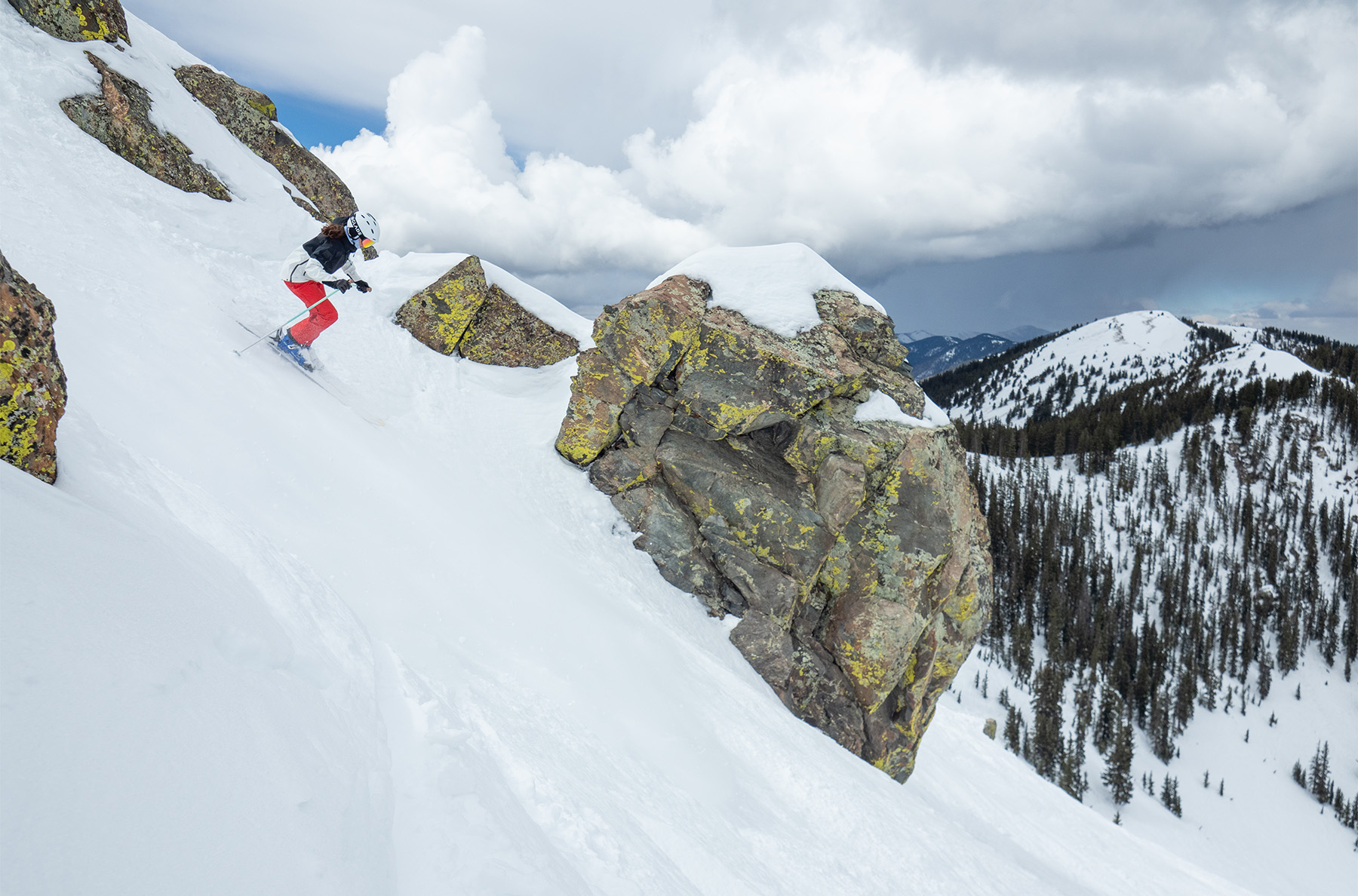
Deep Dive: ZAG Harfang 96 & Harfang 96 Lady
We compare the ZAG Harfang 96 & Harfang 96 Lady to the ZAG Harfang 96, ZAG Slap 104, Dynastar M-Pro 99, Volkl M6 Mantra, Volkl Secret 96, Stöckli Stormrider 95, Salomon Stance 96, Blizzard Anomaly 94, Fischer Ranger 96, Blizzard Black Pearl 97, 4FRNT MSP CC, Nordica Enforcer 99, Nordica Santa Ana 98, Salomon QST 98, Nordica Enforcer 94, J Skis Masterblaster, K2 Mindbender 99Ti, Peak 98 by Bode, Atomic Maverick 95 Ti, Nordica Santa Ana 92, Blizzard Rustler 9, Head Kore 93, Blizzard Black Pearl 94, Faction Dancer 2, Black Crows Camox, Nordica Unleashed 98, RMU Apostle 96 Pro, Line Optic 96, K2 Mindbender 96C, Armada Declivity 102 Ti, Renoun Endurance 98, Shaggy’s Mohawk 98, & Wagner Summit 97.
Blister’s Flash Reviews and Deep Dives are accessible to those who purchase one of our paid subscriptions
To get our comprehensive Deep Dives and our initial, unfiltered reports on new gear, become a member and receive many other services, deals, and discounts.
If you’re already an active member, please log in.
(If you’re already logged in and a member in good standing and seeing this message in error, please refresh this page in your browser.)




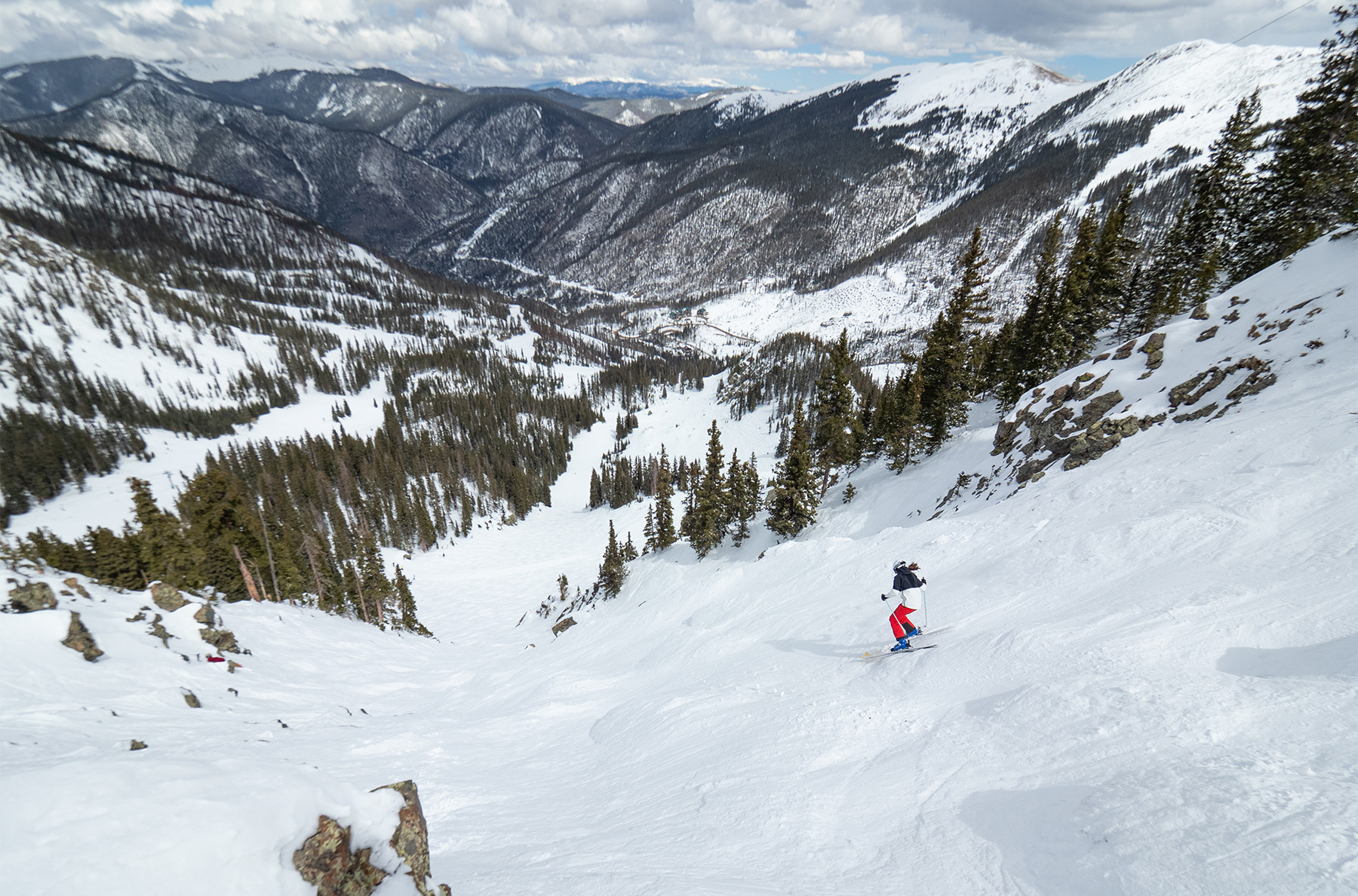
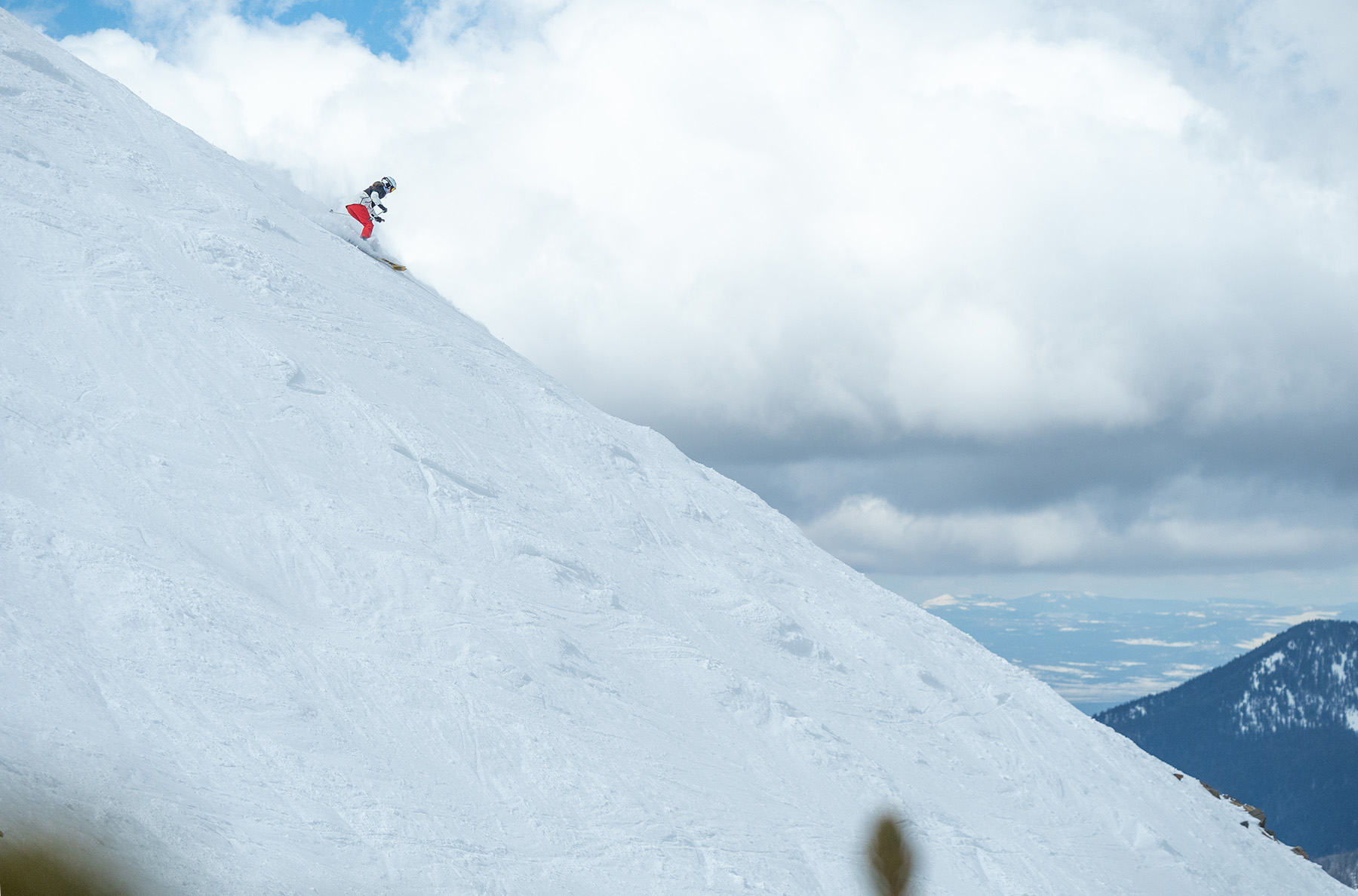
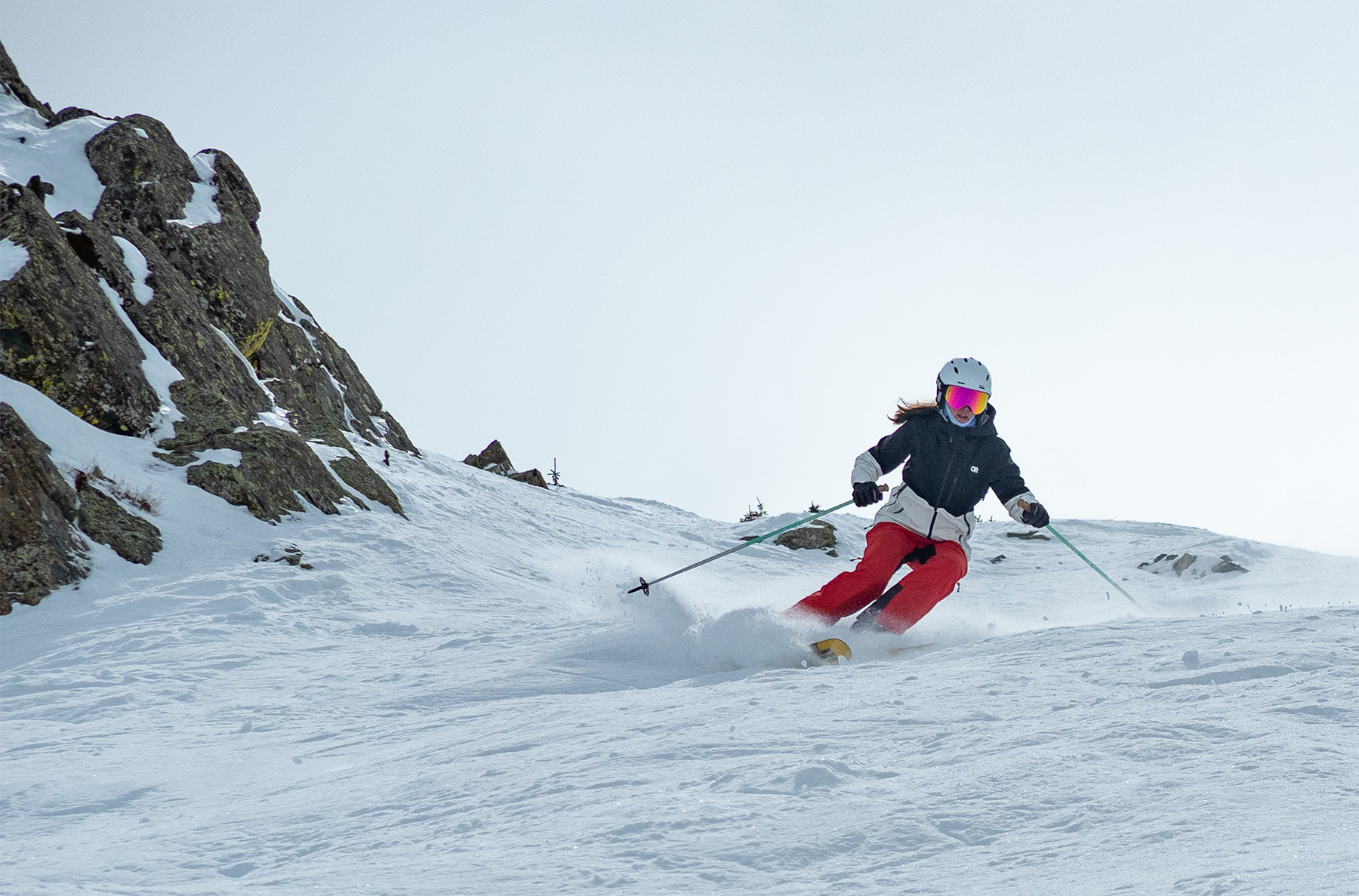
Excellent description of directional/forward/traditional vs. centered skiing technique.
Hi Blister folks – what do you think about the H96 for an occasional light tour? Something like 80/20 resort/touring.
That’d probably be fine — it really just comes down to weight and your particular preferences. The H-96 isn’t a particularly heavy or light ski in the resort class, so I doubt its weight would be a big enough factor to really detract from touring on it ~20% of the time. And if that weight does start to be a factor, then you could always consider adding a dedicated, lighter touring setup. But for an 80/20 split, I’d definitely want to mount it with a burly AT binding (e.g., Shift, CAST, Duke PT), or just use it with Daymaker Adapters.
Thanks, Luke. Duke PT was the plan. Thanks for confirming that it’ll be possible!
On the mount point – am I correct in reading that you’d recommend going +2 forward of the recommended line?
Yeah, I think that the majority of skiers would prefer this ski mounted about -10 cm from true center / +2 cm from recommended.